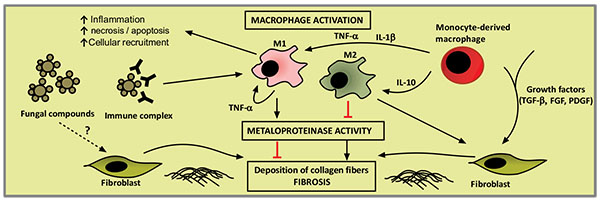Fig. (5)
Proposed overview of fibrogenesis in PCM. The uncontrolled deposition of collagen fibers (types I and III) during a reparative and/or reactive process is recognized as fibrosis and the fibroblasts are the main cell involved in the production of collagens upon stimulation. During prolonged chronic inflammation, macrophages are classically activated (M1) by Th1 cells, pro-inflammatory cytokines and/orimmunocomplexes. These cells show intense production of cytotoxic metabolites to kill pathogens, release pro-inflammatory cytokines, induce tissue necrosis, and recruit phagocytes. Fresh monocytes from peripheral blood and monocyte-derived macrophages release inflammatory cytokines and growth factor that result inmacrophage activationsand fibroblast differentiation. Simultaneously, due to the constant tissue damage, others macrophages are alternatively activated (M2) to stimulatetissue repair. These cells promote the elimination of cellular debris, activation of fibroblast and down-regulate the activities of metalloproteinases, enzymes implicated in extracellular matrix/collagen degradation, promoting deposition of collagen fibers. On the other hand, M1-polarized macrophages up-regulate metalloproteinase activities, resulting in less collagen deposition. Besides the non-regulated, constant and prolonged reparative and reactive processes involved in fibrogenesis, do not rule out the action of molecules of Paracoccidioides in the activation of fibroblast.


